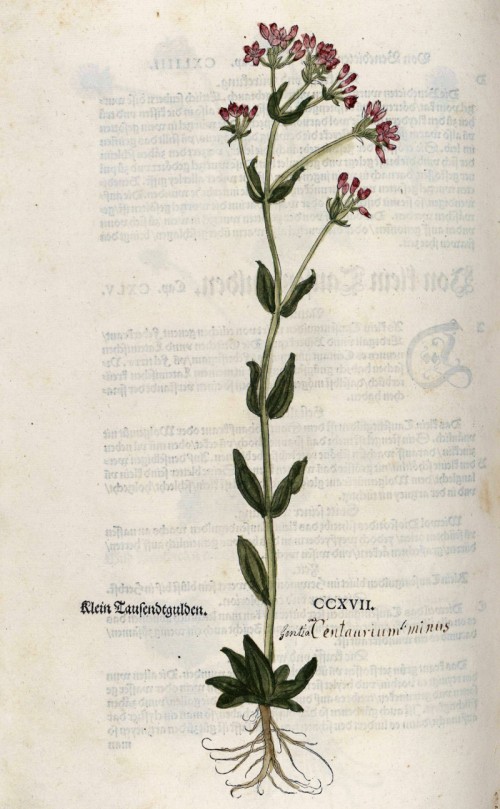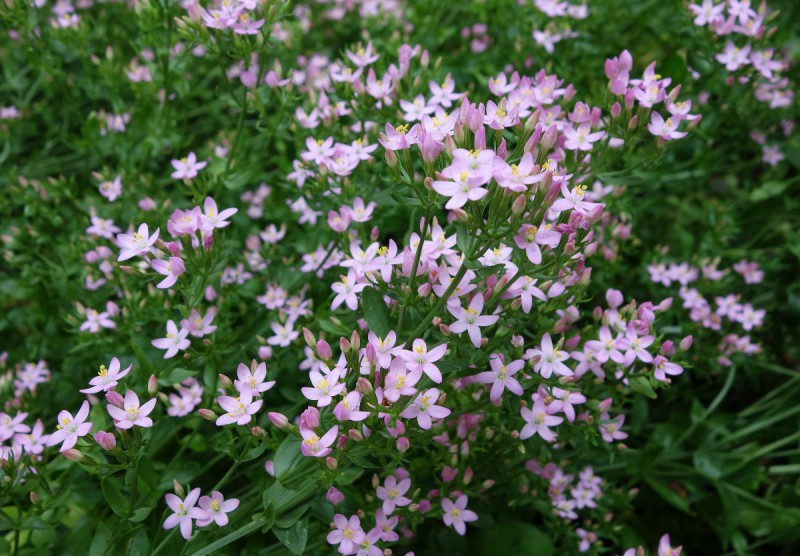Centaurium erythraea Rafn - syn.Centaurium minus aut.; Centaurium umbellatum Gilib.; Erythraea centaurium auct. - Gentianaceae
(common) centaury, Echtes Tausengüldenkraut
Annual or biennial herb, up to 50cm high, native to Eurasia, Central Asia, North Africa, naturalized in North America; leaves basal, oblong (first year); flowers wheel-shaped, pink (second year).
The dried aerial parts of C.erythraea are difficult to distinguish from other Centaurium species. They are used as bitter tonic to increase gastric juice production, to treat dyspeptic disorders and loss of appetite. The flowers have better bitterness values (6000-12000) than leaves (1300-3800) and stems (600-1200), so a high content of flowers is preferred. The secoiridoid glucosides centapicrin and desacetylcentapicrin, located nearly exclusively in the ovary, are minor components but own the greatest bitterness values.
[Kommentar zum DAB10, 1993]
[Hagers Handbuch der Pharmazeutischen Praxis, Springer 2010]
Swertiamarin and sweroside, isolated from the aerial parts of Centaurium erythraea, „… inhibited the growth of Bacillus cereus, Bacillus subtilis, Citrobacter freundiiand Escherichia coli. While swertiamarin was also active against Proteus mirabilis and Serratia marcescens, sweroside inhibited the growth of Staphylococcus epidermidis.“
[Bioactivity of secoiridoid glycosides from Centaurium erythraea., Kumarasamy, Y., Nahar, L., Cox, P. J., Jaspars, M., Sarker, S.D., Phytomedicine, Vol.10(4), 2003, 344-347]
„A bitter tonic to treat digestive disturbances, chronis dyspepsia, and lack of appetite. Traditionally thought to be helpful to treat fever and gastrointestinal, liver, bile, bladder and urological complaints. Externally used for wound treatment…
The plant contains bitter iridoid glycosides, so-called secoiridoids - mainly swertiamarin but also gentiopicrin, deacetylcentapicrin and sweroside.“
[Medicinal Plants of the World. Ben-Erik Van Wyk and Michael Wink, Pretoria 2004, 89]
„The use of Centaurium erythraea Rafn has a long tradition in Europe, mainly in mild dyspeptic/ gastrointestinal disorders and in temporary loss of appetite… The medicinal use has been documented continuously in well-known handbooks… The pharmacological activity is attributed to the whole extract; however emphasis is put on the group of secoiridoid glycosides (‘bitters’) with main components swertiamarin, gentiopicroside, centapicrin and sweroside. Also xanthones, phenolic acids and other ingredients may contribute
to the pharmacological activity of Centaurii herba… There are no clinical safety data for extracts of Centaurii herba. In the documentation of the traditional medicinal use within the Community, no serious adverse effects have been reported.“
[Assessment report on Centaurium erythraea Rafn s. L. including C. majus (H. et L.) Zeltner and C. suffruticosum (griseb.) Ronn., herba, for the development of a community herbal monograph, 2009]
http://www.ema.europa.eu/docs/en_GB/document_library/Herbal_-_HMPC_assessment_report/2009/12/WC500018163.pdf
The methanolic extract (ultrasonic maceration, freeze-dried, 'CE') of C.erythraea contained flavonoides, iridoids and xanthones.
„The short-term (12 days) treatment of the STZ-diabetic rats with CE-extracts resulted in a 74% reduction of the produced hyperglycemia, which is only 6% less than the reduction caused by glibenclamide (GLB, positive control). The CE-extract had a significant impact on the hepatic carbohydrate metabolism enhancing the direct synthesis of glycogen, normalizing phosphorylase a activity and reducing the activity of glucose-6-phosphatase, which further causes reduction in production of blood glucose level. The long-term (45 days) treatment showed that the HbA1c in CE-treated group of animals was even lower than in the GLB-treated groups. The antilipidemic assessment of the CE-extract revealed decrease of total cholesterol, triglycerides, HDL and LDL level in the blood of the normal and STZ-hyperglycemic rats.“
[Chemical characterization of Centaurium erythrea L. and its effects on carbohydrate and lipid metabolism in experimental diabetes., Stefkov, G., Miova, B., Dinevska-Kjovkarovska, S., Stanoeva, J.P., Stefova, M., Petrusevska, G., Kulevanova, S., Journal of ethnopharmacology, Vol.152(1), 2014, 71-77]
„The aqueous extract of E. centaurium, administered to merione at 200 mg/kg for 6 months produced a significant reduction in glycemia, insulinemia, fructosamine and glycosylated haemoglobin. It also exhibited an important decrease of lipidic parameters such as cholesterol, LDL-cholesterol, triglycerids. The results showed no significant diminution of the weight.“
[Effect of Aqueous Extract from Erythrea Centaurium in Merione Shawi., Zaid, A., Int J Diabetol Vasc Dis Res, Vol.2(8), 2014, 1-5]
http://www.scidoc.org/articles%20pdf/ijdvr/IJDVR-2328-353X-02-801.pdf

Centaurium erythraea Rafn [as Centaurium minus]
Fuchs, L., New Kreüterbuch, t.217 (1543)
http://plantgenera.org/species.php?id_species=220560

Centaurium erythraea, CC BY-SA 3.0, Author: Andreas Kraska

